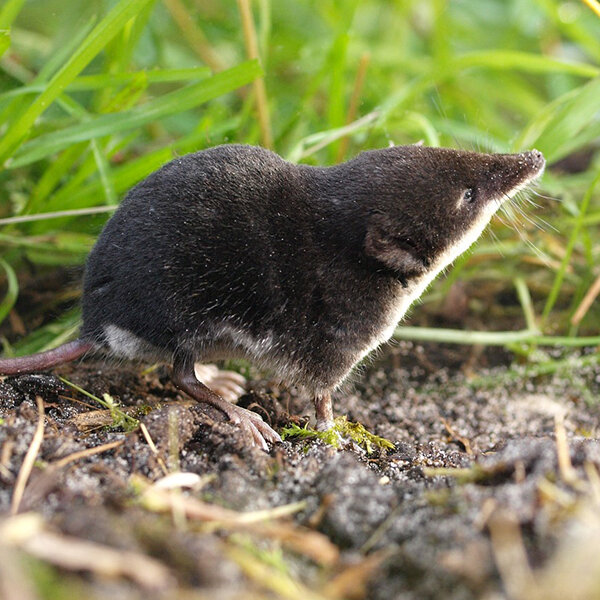Water shrew
Neomys fodiens
As its name suggest, the water shrew is a semi-aquatic species found close to water bodies such as streams, ponds, rivers, reed-beds and fens. They are excellent swimmers, and can often be spotted swimming underwater and diving to depths of 30 to 200cm. Whilst swimming, their fur traps thousands of air bubbles which makes the fur appear silvery and provides important insulation.
The water shrew is the largest of the shrews found in the UK measuring 6 -10cm plus a tail of 4-8cm. It is distinctively jet black on the upper surface, and pale white/silvery on the lower surface, with a very clear demarcation. The fur is often described as velvety with short, dense hairs which are very effective at insulating them against the cold and wet. To keep their fur in good condition and prevent water-logging, they frequently groom themselves by licking.
They have tufts of white hairs on their ears and also around their eyes. Stiff white hairs on the margins of the feet and a fringe on the underside of the tail forming a keel are very distinctive. They have a long snout, small ears and tiny eyes. Water shrews have relatively large hind feet, but despite spending much time in water their feet are not webbed.
Their teeth often look reddish due to the deposition of iron in the enamel of the tips of the teeth. This is thought to help with reducing wear and tear. They live in burrows and emerge to feed on invertebrates.
They have a short lifespan lasting no more than 19 months. They breed in the summer months producing 2 or 3 litters each with 3-15 young in nest woven from dry grass within a burrow or beneath a log. Their main predators are barn and tawny owls, and occasionally kestrels, foxes and predatory fish. Shrews possess scent glands which produce strong-smelling oily substances which predators such as the domestic cat, find unpleasant.
What they eat
They feed on prey such as freshwater shrimps, beetles, caddis fly and mayfly larvae; and frogs, newts or small fish. They will also take terrestrial invertebrates such as earthworms and beetles.
Where and when to see them
Water shrews do not hibernate and are active throughout the year, especially at night.
Usually found close to water bodies such as streams, ponds, rivers, reed-beds and fens.
They are particularly fond of water-cress beds, but can also be found in habitats away from water bodies such as grasslands, hedgerows and gardens.
Use your ears! All shrews make a high-pitched, squeaking sound known as ‘twittering’.
View a water shrew 10km distribution map of Wales.
Legal status
Water shrews are protected under Schedule 6 of the Wildlife & Countryside Act 1981 (as amended).
Field Signs
Droppings are up to 10mm long and black when wet and pale grey when dry and they may contain fragments of crustaceans. They are often deposited on streamside rocks or burrow entrances.
Burrows are made in the banks of streams and rivers, and measure about 20mm across. They can form extensive networks along waterside banks.
Their high-pitched squeaking may be mistaken for crickets or birds so take a recording if you can.
Similar species
Common shrew (Sorex araneus)
Common shrews measure 48-80mm, and have short velvet-like fur which is tri-coloured: dark brown on top, paler brown in the middle, and a very pale colour underneath. They have very small eyes and ears and a long pointed snout. Their tail is less than 75% of their body length and slightly hairy. They can be found in most habitats, but prefer woodland and grassland, and are active by day and night.
Pygmy shrew (Sorex minutus)
The pygmy shrew is the smallest native British mammal weighing only 2.4-6.1g, and measuring 4-6cm with a tail of 32 to 46mm. It has a domed head, is bi-coloured with a greyish-brown colour on top and pale grey/silver below, and has a proportionally longer and hairier tail (tail is >75% of body length). They never have white ear tufts. They can be found in most habitats and are active by day and night. They eat 125% of their body weight every day!
Other links
Did you know?
Water voles immobilise prey by using their venomous saliva delivered by grooves in their teeth. A water shrew is able to tackle prey up to 60 times heavier than itself.
Be warned: if bitten by a water shrew you could also feel the effects of the venom, a sore red rash may appear at the site of the bite.

